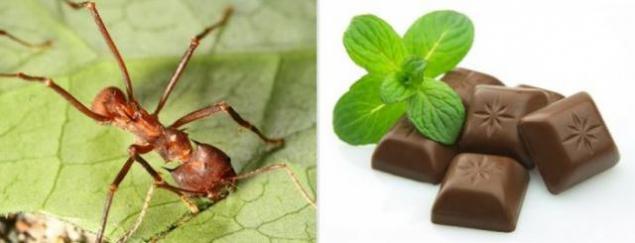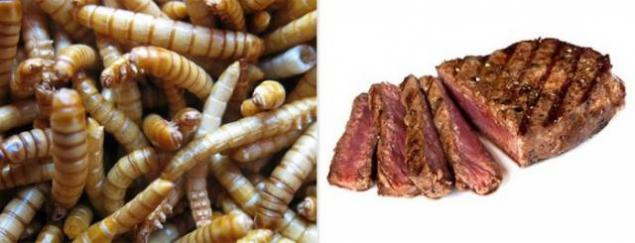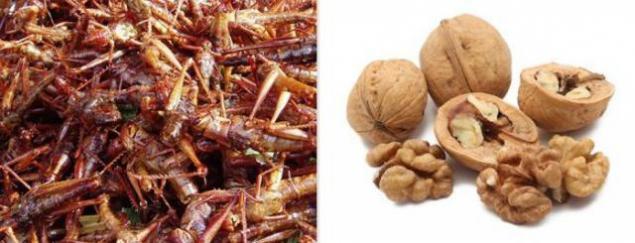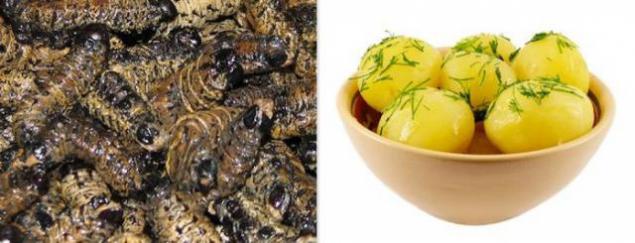900
Food that is disgusting
Meals around the world, which seems just disgusting, but it is considered a delicacy in this country. where it is cooked.
Leaf-cutting ants (400 kcal per 100 grams of weight) vs chocolate (550 calories per 100 grams of weight)
Despite the aversion of the population of Western countries to eating insects, the UN hopes to change attitudes towards entomophages. It is planned to organize a campaign in which scientists will educate the public on issues related to the use of insects as food. As a result, it is hoped the UN, progressive people pay attention to this untapped resource. Finally, remind the organization, the food is largely determined by the habits and fashion.

Track mopane (540 milligrams phosphorus per 100 grams of weight) vs veal (200 milligrams phosphorus per 100 grams of weight)
Different preferences in food, usually due to differences in culture, which, in turn, formed under the influence of religious beliefs. Mention entomophages contained in the Christian, Islamic and Jewish literature. For example, a passage from the Bible: "All winged insects that go upon all four [feet], an abomination to you; of every creeping thing that goeth four [feet], may eat those which have legs above their feet, to leap withal upon the earth; So eat of them: the locust according to its kind, the bald locust after his kind, the cricket according to its kind, and the grasshopper according to its kind "(Leviticus, chapter 11)

Mealworms (90 grams of omega-6 100 grams of weight) vs beef (10 grams of omega-6 100 grams of weight)
In Europe, one of the first references to the use of insects as food is to the ancient Greek period. "Beget they [cicadas] and reeds that support the vines and stems skills. These rudiments then fall down on the ground. They arise in large numbers in the rainy season. The worm, which grew in the ground, it becomes tsikadnoy uterus, and then they are the most delicious, before bursting shell "(" History of Animals "Aristotle).

Grasshoppers (46 grams of omega-6 100 grams of weight) vs walnuts (28 grams of omega-6 100 grams of weight)
Insect eaten including the ancient Romans. So, Pliny the Elder wrote that the Empire is especially appreciated beetle larvae barbel big oak (Cerambyx cerdo). Considered the founder of modern Italian entomophages Ulisse Aldrovandi. He mentioned in his writings that the insects ate mainly in Eastern civilizations, primarily in China.

The caterpillars mopane (1,000 milligrams of potassium per 100 grams of weight) vs potatoes (630 milligrams of potassium per 100 grams of weight)
In today's world of insects are eaten in Mexico, Africa, Southeast Asia and Australia. The most popular edible insects are beetles, caterpillars, bees, wasps, ants, grasshoppers, locusts, crickets, cicadas, butterflies, flies. The most delicious, judging by the popularity, are the larvae of the red palm weevil (Rhynchophorus ferrugineus) and the caterpillar mopane (Imbrasia belina). The food is also willing to use bamboo worms, tarantulas and even some kinds of bugs.

Locust (28 grams protein per 100 grams of weight) vs lobster (19 grams protein per 100 grams of weight)
In the western world of insects not only eat - the mere mention of the use of them for food, many can cause a gag reflex. The unequivocal answer to the question why entomophages not favor in the West, do not. One of the most popular theory is that Christian preachers proclaimed in his time eating insects pagan tradition. In addition, Western culture was felt that entomophagy - the lot of the hungry and backward peoples.

Mexican grasshoppers chapulín (48 grams protein per 100 grams of weight) vs mackerel (28 grams protein per 100 grams of weight)
The UN believes that the attitude to entomophages worth reviewing for several reasons. In particular, insects require less feed than the animals. To get a kilo of chicken meat must be 2, 5 kilograms of feed, pork - five kilograms of beef - ten kilograms of food. For comparison, to one kilogram edible grasshoppers need 1 7 kilograms of feed.

Palm beetle larvae (36 grams protein per 100 grams of weight) vs squid (18 grams protein per 100 gram weight)
Growing insect is more environmentally friendly. Livestock contributes about 18 percent of global greenhouse gas emissions, ie the industry pollutes the environment more than the transport sector. Insects are responsible for emissions of a hundred times smaller than the volume of harmful gases; moreover, it requires much less water.

Crickets (25 grams protein per 100 grams of weight) vs pork (15 grams protein per 100 grams of weight)
The UN believes that the insects can breed for later consumption. In some countries, this industry has been interested in business. In particular, Thailand, Laos and Vietnam are bred crickets. So far, however, the cultivation of insect not put on stream, even in those countries where entomophagy is a tradition. Locals crickets bred in barns in the backyards of their homes.

Termites (530 kcal per 100 grams of weight) vs doctoral sausage (260 kcal per 100 grams of weight)
The few entrepreneurs who have decided to breed insects, face many challenges; The main reason - the lack of relevant experience in an industrial scale. This industry can be profitable only if the insect can be grown in large quantities. In addition, due to the negative attitude of the West towards a more developed entomophages this phenomenon are poorly understood. Some supporters entomophages offer to build the breeding of insects in the category of academic disciplines.

Termites (28 grams protein per 100 grams of weight) vs perch (18 grams protein per 100 grams of weight)
One of the pioneers in the breeding of insects in Europe was the Dutch Kreca. It is a family company that has 35 years provides insects - mostly manufacturers of animal feed. Kreca grows beetle larvae, cockroaches, grasshoppers, which are first dried and then frozen. Subsequently, these insects can be ground into flour and used to extract the dried protein. It is possible that some consumers already eat insects in a manner completely unaware about it.

Ant-Taylor (1270 kcal per 100 grams of weight) vs pork bacon (720 calories per 100 grams of weight)
An example of a successful company, a dilution of insects, can also serve as the South African AgriProtein, which grows ordinary houseflies. Manufacturing is the inexpensive relative - as a food company uses bowel movements, including human. Flies reproduce, employees collect eggs that are dried and ground. AgriProtein started with a very small production volumes, now in the day produced a few hundred kilograms of dry protein in the future it is planned to increase production volumes of up to one hundred tons per day.

Australian locusts (499 kcal per 100 grams of weight) vs summer sausage (470 kcal per 100 grams of weight)
Rearing of insects for human consumption may be less profitable than the production of one protein powder for animals. For example, a kilogram of larvae of ants sort Liometopum intermediaries in Mexico produce $ 30 and then resell to foreign companies at least six times more expensive. In Laos, grasshoppers kilogram costs up to ten euros, and in the Netherlands, the same amount will have to pay 35 grasshoppers.

Leaf-cutting ants (400 kcal per 100 grams of weight) vs chocolate (550 calories per 100 grams of weight)
Despite the aversion of the population of Western countries to eating insects, the UN hopes to change attitudes towards entomophages. It is planned to organize a campaign in which scientists will educate the public on issues related to the use of insects as food. As a result, it is hoped the UN, progressive people pay attention to this untapped resource. Finally, remind the organization, the food is largely determined by the habits and fashion.

Track mopane (540 milligrams phosphorus per 100 grams of weight) vs veal (200 milligrams phosphorus per 100 grams of weight)
Different preferences in food, usually due to differences in culture, which, in turn, formed under the influence of religious beliefs. Mention entomophages contained in the Christian, Islamic and Jewish literature. For example, a passage from the Bible: "All winged insects that go upon all four [feet], an abomination to you; of every creeping thing that goeth four [feet], may eat those which have legs above their feet, to leap withal upon the earth; So eat of them: the locust according to its kind, the bald locust after his kind, the cricket according to its kind, and the grasshopper according to its kind "(Leviticus, chapter 11)

Mealworms (90 grams of omega-6 100 grams of weight) vs beef (10 grams of omega-6 100 grams of weight)
In Europe, one of the first references to the use of insects as food is to the ancient Greek period. "Beget they [cicadas] and reeds that support the vines and stems skills. These rudiments then fall down on the ground. They arise in large numbers in the rainy season. The worm, which grew in the ground, it becomes tsikadnoy uterus, and then they are the most delicious, before bursting shell "(" History of Animals "Aristotle).

Grasshoppers (46 grams of omega-6 100 grams of weight) vs walnuts (28 grams of omega-6 100 grams of weight)
Insect eaten including the ancient Romans. So, Pliny the Elder wrote that the Empire is especially appreciated beetle larvae barbel big oak (Cerambyx cerdo). Considered the founder of modern Italian entomophages Ulisse Aldrovandi. He mentioned in his writings that the insects ate mainly in Eastern civilizations, primarily in China.

The caterpillars mopane (1,000 milligrams of potassium per 100 grams of weight) vs potatoes (630 milligrams of potassium per 100 grams of weight)
In today's world of insects are eaten in Mexico, Africa, Southeast Asia and Australia. The most popular edible insects are beetles, caterpillars, bees, wasps, ants, grasshoppers, locusts, crickets, cicadas, butterflies, flies. The most delicious, judging by the popularity, are the larvae of the red palm weevil (Rhynchophorus ferrugineus) and the caterpillar mopane (Imbrasia belina). The food is also willing to use bamboo worms, tarantulas and even some kinds of bugs.

Locust (28 grams protein per 100 grams of weight) vs lobster (19 grams protein per 100 grams of weight)
In the western world of insects not only eat - the mere mention of the use of them for food, many can cause a gag reflex. The unequivocal answer to the question why entomophages not favor in the West, do not. One of the most popular theory is that Christian preachers proclaimed in his time eating insects pagan tradition. In addition, Western culture was felt that entomophagy - the lot of the hungry and backward peoples.

Mexican grasshoppers chapulín (48 grams protein per 100 grams of weight) vs mackerel (28 grams protein per 100 grams of weight)
The UN believes that the attitude to entomophages worth reviewing for several reasons. In particular, insects require less feed than the animals. To get a kilo of chicken meat must be 2, 5 kilograms of feed, pork - five kilograms of beef - ten kilograms of food. For comparison, to one kilogram edible grasshoppers need 1 7 kilograms of feed.

Palm beetle larvae (36 grams protein per 100 grams of weight) vs squid (18 grams protein per 100 gram weight)
Growing insect is more environmentally friendly. Livestock contributes about 18 percent of global greenhouse gas emissions, ie the industry pollutes the environment more than the transport sector. Insects are responsible for emissions of a hundred times smaller than the volume of harmful gases; moreover, it requires much less water.

Crickets (25 grams protein per 100 grams of weight) vs pork (15 grams protein per 100 grams of weight)
The UN believes that the insects can breed for later consumption. In some countries, this industry has been interested in business. In particular, Thailand, Laos and Vietnam are bred crickets. So far, however, the cultivation of insect not put on stream, even in those countries where entomophagy is a tradition. Locals crickets bred in barns in the backyards of their homes.

Termites (530 kcal per 100 grams of weight) vs doctoral sausage (260 kcal per 100 grams of weight)
The few entrepreneurs who have decided to breed insects, face many challenges; The main reason - the lack of relevant experience in an industrial scale. This industry can be profitable only if the insect can be grown in large quantities. In addition, due to the negative attitude of the West towards a more developed entomophages this phenomenon are poorly understood. Some supporters entomophages offer to build the breeding of insects in the category of academic disciplines.

Termites (28 grams protein per 100 grams of weight) vs perch (18 grams protein per 100 grams of weight)
One of the pioneers in the breeding of insects in Europe was the Dutch Kreca. It is a family company that has 35 years provides insects - mostly manufacturers of animal feed. Kreca grows beetle larvae, cockroaches, grasshoppers, which are first dried and then frozen. Subsequently, these insects can be ground into flour and used to extract the dried protein. It is possible that some consumers already eat insects in a manner completely unaware about it.

Ant-Taylor (1270 kcal per 100 grams of weight) vs pork bacon (720 calories per 100 grams of weight)
An example of a successful company, a dilution of insects, can also serve as the South African AgriProtein, which grows ordinary houseflies. Manufacturing is the inexpensive relative - as a food company uses bowel movements, including human. Flies reproduce, employees collect eggs that are dried and ground. AgriProtein started with a very small production volumes, now in the day produced a few hundred kilograms of dry protein in the future it is planned to increase production volumes of up to one hundred tons per day.

Australian locusts (499 kcal per 100 grams of weight) vs summer sausage (470 kcal per 100 grams of weight)
Rearing of insects for human consumption may be less profitable than the production of one protein powder for animals. For example, a kilogram of larvae of ants sort Liometopum intermediaries in Mexico produce $ 30 and then resell to foreign companies at least six times more expensive. In Laos, grasshoppers kilogram costs up to ten euros, and in the Netherlands, the same amount will have to pay 35 grasshoppers.

























